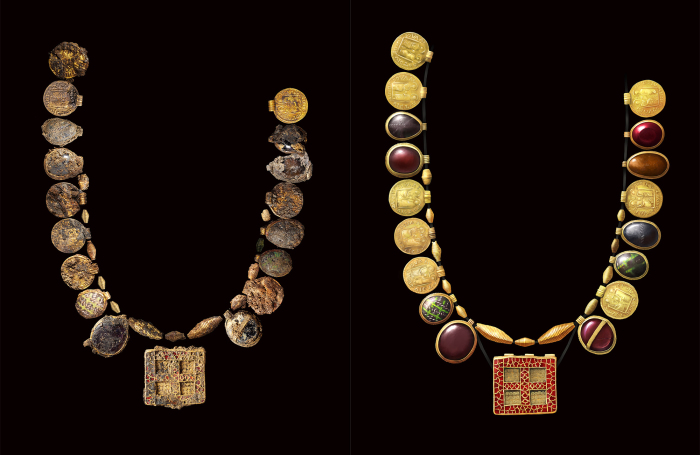Archaeologists find 7th-century necklace that may have adorned early female Christian leader

Archaeologists have uncovered an ancient gold, gemstone necklace at a burial site in England that is believed to have once adorned the neck of an affluent, Christian female leader who walked the earth 1,300 years ago.
The jewelry was uncovered at the Northamptonshire village burial site in Britain's Midlands in April 2022. Archaeologists also found a large ornate cross with inset garnets and pectoral crosses at the end of each arm.
According to the Museum of London Archeology, experts said the second finding furthered their belief that both discoveries were possibly the belongings of a seventh-century Christian woman buried there who may have been an early Christian leader.
The gold charm and the cross date back to 630 to 670 A.D.
While the cross is still under review, as it is being micro-excavated, the necklace itself has been given a nickname, "Harpole Treasure." The nickname stems from the Central London village, where both discoveries were uncovered.
The Museum of London Archeology is one of the organizations involved in the Northamptonshire dig on behalf of Vistry Group. The "Harpole Treasure" has a shocking number of never-before-seen pendants and is made up of intricate patterns, shapes and designs.
The necklace is also thought to have once been vibrant with burgundy, blue, red, green and gold on its pendants, according to side-by-side photos shared by the museum of how the necklace appears today and what it once looked like centuries ago.
"When the first glints of gold started to emerge from the soil we knew this was something significant. However, we didn't quite realise how special this was going to be," MOLA Site Supervisor Levente-Bence Balázs said in a statement.
The museum describes itself as "an experienced and innovative archaeology and built heritage practice" that has been "providing independent, professional heritage advice and services for over 40 years across the UK and internationally on schemes both large and small."
The "Harpole Treasure" is set apart from other necklaces with similar pendants that have been discovered at burial sites in the past. A similar necklace was found in Northhamptonshire in 1876 and is believed to be the "finest" necklace of this variety and stored at the British Museum. However, it is unclear if that necklace is complete because workers portioned off pendants and beads amongst themselves before handing them over for a small reward.
By comparison, the museum says the "Harpole Treasure necklace is complete."
"The necklace is made up of a staggering number of pendants. There are gold Roman coins, semi-precious stones set in gold and decorated glass pendants set in gold. Along with these are several gold bead spacers that spaced out the pendants in the necklace," Katherine Newton, a MOLA communications officer, wrote in a report on the findings.
"The centerpiece of this necklace is a large rectangular pendant made of red garnets and gold, with a cross motif. We think that it was originally half of a hinge clasp before it was re-used in this necklace."
The dig was done on land developed by the Vistry Group, a home-building company that "delivers thousands of homes annually for both the open market and the affordable housing sector."
"It is unlikely the treasure would ever have been found without the Vistry-funded archaeology work, which was preparing the ground for a new-home location in Harpole," reads a Vistry Group report.
"The necklace has yet to be valued, but is thought to be one of the most significant archaeological finds in recent years. The team of archaeologists made the astonishing discovery earlier this year."
Daniel Oliver, the regional technical director for Vistry in West Midlands, said the artifacts will be gifted to the nation, and any ownership rights by Vistry Group have been waived.
"This is such an important find. It was important for us to do the right thing and ensure they were protected for many years to come," Oliver said in a statement. "Having personally seen this treasure on site, I could not be more excited to see how much more has been learned already. It is an amazing find."
According to MOLA, fragments of tooth enamel were traced from the burial grounds. However, no human remains were recovered from the site. X-rays show the large ornate cross includes "unusual depictions of human faces cast in silver."
The necklace and cross make the findings "one of the most spectacular female early medieval burials ever discovered in the U.K," MOLA's Newton stressed.
"We currently think that it is almost certainly a female burial because similar necklaces and extravagant burials are almost exclusively found in female burials in this period," Newton added.
Archaeologists say the findings could serve as a way to help educate generations to come about life in seventh-century England. The period in history is commonly known as an era when Christianity faced heavy backlash, as paganism was taking the allegiance of the masses.
Lyn Blackmore, a senior finds specialist at MOLA, told The Associated Press that she can infer from just a glance at the necklace and cross that the potential female owner of the items was financially prosperous in her time.
"A definite statement of wealth, as well as Christian faith," Blackmore said.
"She was extremely devout, but was she a princess? Was she a nun? Was she more than a nun — an abbess? … We don't know."
Nicole Alcindor is a reporter for The Christian Post. She can be reached at: nicole.alcindor@christianpost.com.





























